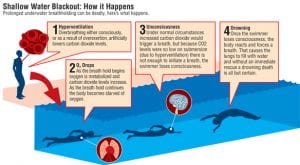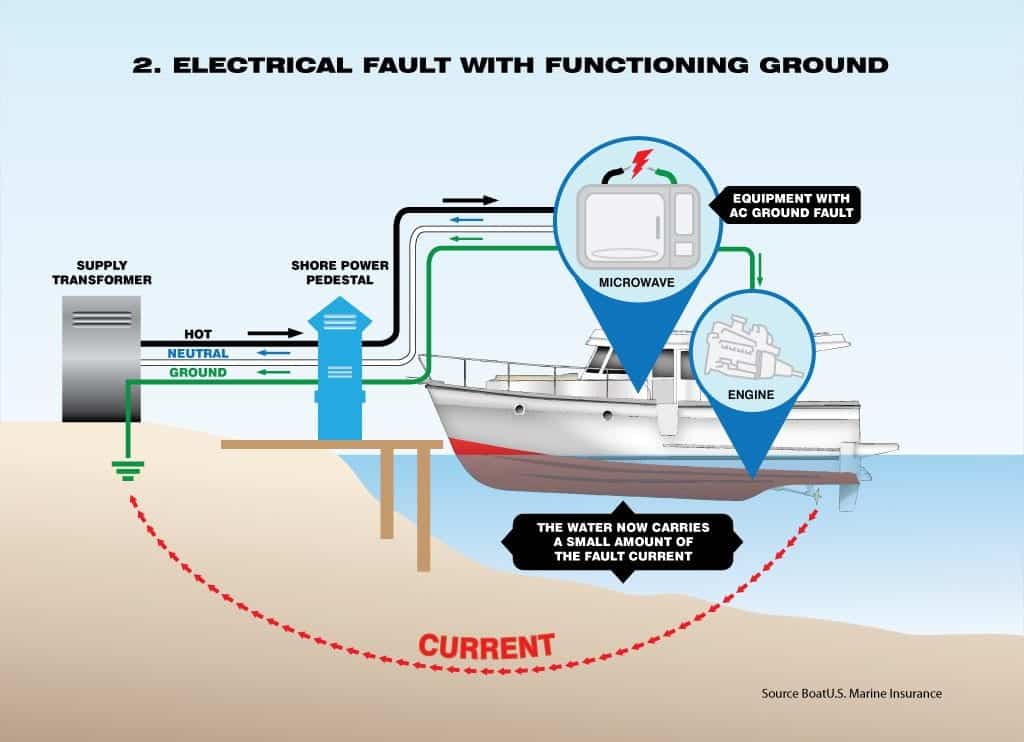Shallow Water Blackout and Electric Shock Drowning
As the weather warms, it’s time for many of us to get back in the water. There are, however, risks. Two of the lesser known but very dangerous situations are shallow water blackout (SWB) and electric shock drowning (ESD).
Shallow Water Blackout
SWB is when a person blacks out while underwater due to breathing irregularities, such as hyperventilating before you go under and holding your breath too long while under. SWB
can quickly lead to drowning. SWB can affect any swimmer, even highly trained and
fit athletes. In fact, it’s often the better swimmers who can succumb. Besides competitive swimmers who limit breathing to increase speed, those who hold their breath to go underwater, such as snorkelers, spear fishermen and free divers, should be aware of SWB. Hyperventilation, before you go under, can hasten the effect. Even breath-holding games can be dangerous.

What causes SWB? When you hold your breath, a lack of oxygen to the brain, officially known as hypoxia, can result. This may cause a blackout. At the same time, elevated levels of carbon dioxide will make you take a breath which can lead to drowning if you take in water and it infiltrates the lungs. Just the lack of oxygen itself can result in significant brain damage and even death. Hyperventilation and repetitive breath-holding
increase the risk.
SWB can happen in any situation when you’re in the water. The term shallow water was a reference to incidents that occurred when free divers were ascending from deep dives. SWB is particularly dangerous because it can strike a victim without any warning or precursory signs. Rapid unconsciousness not only prevents you from taking action, but there will also be little sign of your distress to others unless they are close to you.
Because brain cells have already been deprived of oxygen due to the breath-holding, brain damage can occur within a few minutes—much faster than with typical drowning
incidents. Swimming in warm water will also hasten these effects. To prevent SWB, avoid hyperventilating and prolonged breath-holding and never swim alone. Even if a lifeguard is on duty, SWB can strike too quickly for them to help.
Electric Shock Drowning
Like SWB, ESD is a little known but very real danger for swimmers. Even a low-level AC current permeating the water can cause muscular paralysis and an inability to use your arms and legs. Drowning can occur quickly, and a stronger current may induce electrocution.
There is no way of telling if this situation is happening because there are no visible signs. Numerous cases involved people who had been swimming for some time but became
victims when an electrical charge was initiated. The simple flicking of a switch can instantaneously turn the water from safe to deadly.
Anywhere an electrical outlet is near water, ESD is possible. Most often, this occurs near docks and marinas. Usually, a cable is connected from the dock to a moored boat. If a piece of equipment has an AC ground fault, a dangerous electrical charge can enter the water.

Most ESDs have taken place in fresh water. It’s believed that the increased conductivity of salt water would prevent this from happening; however, there can be an exception. If the saltwater swimming area is close to a freshwater outlet, such as a stream or river, problems can occur. Significant runoff from a heavy rain event can produce a layer of fresh water on top of the salt water (fresh water is less dense). This freshwater layer can be several feet deep and could support an ESD situation.
In ESD cases, it is typically impossible for someone to come to your rescue because they would also succumb to the electrical force. The only solution is to disconnect the source
of electricity and then save the victim. To be completely safe from ESD, never swim around marinas, docks or anywhere electrical outlets are near the water.
What can you do?
Boat owners should have their boat inspected by a qualified electrician to make sure the electrical system will not leak current into the water. Marina owners and managers should be encouraged to install ground-fault circuit interrupters (GFCIs) on all shore power pedestals and marina wiring circuits. Prohibiting swimming near marinas and docks should also be enforced. There are devices on the market which can detect electrical current in the water. If none is present, there is a “Green Light for Swimming.”
However, as mentioned above, the water can become deadly in a fraction of a second when before it was deemed safe. Regulation on electrical apparatus on docks and marinas is coming, though slowly.
For both SWB and ESD, it’s impossible to know how many cases have actually occurred. Unless someone witnesses the event, any fatalities will likely be attributed to more common causes of drowning (cramps, intoxication, etc.).
Experts assume that SWB and ESD claim many more victims than officially noted. For both SWB and ESD, the key is education. Swimmers should be aware of both situations and how to avoid them.
shallowwaterblackoutprevention.org
electricshockdrowning.org
By Ed Brotak, Southern Boating
May 2019













